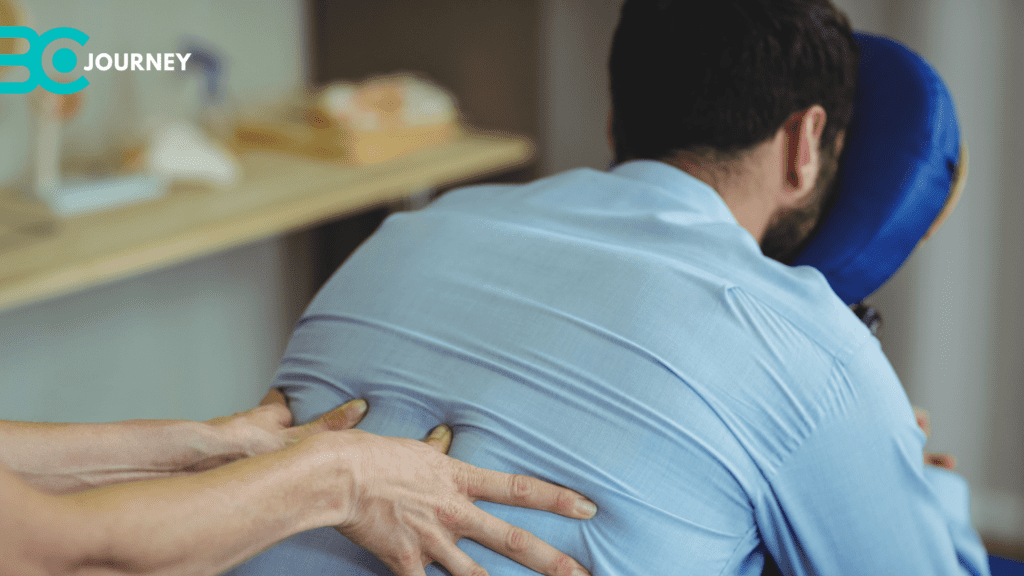Many people experience back pain with walking. It’s one of the most common complaints of all ages and we know how frustrating it can be when even your very basic activity such as walking gets affected. Walking Is Good Exercise It should be gentle and steady walking, good for overall health.
But for quite a few, pain can take the form of discomfort, especially in the lower back. Until we can understand the core of this pain, then it is difficult to release and stop further discomfort.
Common Causes of Back Pain While Walking
Low back pain when walking has various causes, ranging from postural problems to genuine illnesses. By identifying the cause, one can then take steps aimed at relieving and, as much as possible, preventing that pain.
Poor Posture and Its Impact on Back Pain
Poor posture is one of the most common causes of back pain when walking. When you clink or fail to arrange your body properly, you are putting extra strain on your spine; as a result, discomfort and pain result.
Maintaining a proper posture while walking involves standing tall with your shoulders back, your head aligned with your spine, and your weight evenly distributed on both feet. Improving your posture can significantly reduce the incidence of back pain.
Muscle Strain and Overuse
A muscle strain occurs when the muscles in the back are overworked from constant walking or intensive exercise or when they are stretched too far. All this can be worsened by little or no warm-up, training on uneven surfaces, and long steady hikes.
Over time, continuous movements, and everyday activities can lead to chronic overload and, therefore, chronic pain.
Degenerative Disc Disease
This is a condition where the cushions of the discs between the backbones disintegrate or collapse hence causing pain. At this point, you will have problems walking as the discs cannot cushion the spines.
Spinal Stenosis
It is defined as a nerve compression that emanates from the narrowing of the spaces in the backbone. The back pain experienced will increase with walking, which is one of the major causes of these conditions. Walking for long periods can cause more profound pain with this stenosis. Sciatica and nerve compression
Sciatica and Nerve Compression
It is commonly known as the shooting pain in the lower back, which extends to one side of your body, hips, and legs. The shooting pain is a result of pressure on the sciatic nerves, which run from your lower back to the two legs.
This pain is severe and may cause a person not to walk. The compression of nerves can only be cured by standard medical treatment.
Obesity and Its Role in Back Pain When Walking
Obesity is mostly termed as the abnormal increase in body fat, which reduces and affects your movement. It is a contributing factor to back pain while walking.
Obese people experience back pain because of the weight caused by the accumulation of fats in the backbone. It may cause excruciating pain to their back; hence they cannot walk.
Symptoms of Severe Back Pain When Walking
It is essential to look at how pain appears to better understand the next step to manage it effectively.
Identifying Symptoms of Lower Back Pain
Lower back pain has many ways of presenting itself, from a dull ache to sharp stabbing sensations. Common symptoms include stiffness, an inability to move well, and pain that gets worse when you move.
If the root of back pain is the spine or muscles, a walk could easily worsen it. Even the slightest motion has repercussions for sufferers with these complaints.
Sudden Onset of Severe Back Pain
when walking suddenly causes intense discomfort in one’s back the problem likely lies in a serious condition such as a herniated disc or spinal fracture. Medical treatment is necessary for diagnosis and curative measures.
Pain Radiating to Hips and Legs
When a backache radiates to the hips and legs, the nerves are likely affected. Sciatica is an example of this. This kind of pain makes walking and standing intolerable, both its symptoms and root cause should be comprehensively addressed through treatment exercises.
How can I stop my back from hurting when I walk?
The best way to cure injury is to prevent it, and several strategies can help you avoid getting injured in the first place by preventing back pain during walking.
Proper walking techniques
How you walk significantly affects your back health. To prevent back pain, make sure you maintain an upright posture, stride evenly, and don’t over-stride, which will otherwise result in tightening the muscles of your lower back.
If you walk with your core engaged, this can help to stabilize your spine and decrease the possibility of pain.
Strengthening Exercises for Back Health
Strengthening the muscles that support your spine is crucial for avoiding back pain. Exercises targeting the lower back, such as planks, bridges, and bird dogs, can improve muscle endurance and reduce your risk of pain.
Incorporate these exercises into your routine as a way to protect your back during walking and other activities.
Stretching to reduce back pain
Stretching is an effective way to lower a muscle’s tension and increase flexibility. Both of these factors are also important in preventing back pain.
This means focusing on stretches for your lower back, hamstrings, and hip flexors. Stiffness in these areas can give rise to back pain during walking
Footwear and Its Influence on Back Pain
The shoes you wear can have a huge effect on your back health. Good footwear provides adequate support and cushioning, which help absorb the shock of walking and lessen the strain on your back.
Look for shoes with good arch support and avoid high heels, or shoes lacking support, because these can increase your risk of back pain.
Ergonomic Support and Tools
Ergonomic devices like walking sticks, or lumbar support belts, can provide additional support for your spine and reduce back pain.
Those tools can be particularly helpful for those of us in whom pain as in from any of the conditions described above, spinal stenosis, herniated disc disease, or sciatica.
When to Seek Medical Attention for Back Pain

Being able to know when you should seek medical attention is very important in the effective management of back pain.
Recognizing Serious Back Pain Conditions
Severe back pain that does not get better when you rest and after you take over-the-counter pain medication, severe pain accompanied by numbness or weakness, and pain resulting from a fall or a blow to your back require medical attention. These symptoms could indicate that you have a herniated disc or a fracture of the spine. The pain could also be a result of nerve damage.
Diagnostic Tests for Back Pain
If you have persistent back pain, your doctor may start by ordering various diagnostic tests such as x-rays, MRIs, and CT scans to help determine the underlying cause. These examinations help identify problems like herniated disks or spinal stenosis, which might need special treatment.
Treatment Options for Back Pain when walking
Treating back pain can be done in a variety of ways, with options ranging from conservative treatment to invasive surgery.
Conservative Treatments for Back Pain
Conservative treatments include over-the-counter pain relievers, physical therapy, and modifying your lifestyle. A regimen of well-applied physical therapy can be particularly useful in relieving pain and regaining movement.
Physical therapists can design specific exercises for your particular source of pain and therefore help you restore strength and flexibility.
Invasive Treatments for Severe Back Pain
In cases where conservative treatments are not providing relief, invasive treatments such as injections or surgery may be considered.
These injections may give temporary relief by decreasing inflammation, and surgery also might become necessary to correct structural problems like herniated disks or spinal stenosis.
Alternative Therapies for Back Pain when walking
Such alternatives as acupuncture, chiropractic care, and massage therapy can add to standard treatments and give added relief. They concentrate on relieving pain with non-invasive methods while bolstering general well-being.
Lifestyle Changes to Reduce Back Pain
For a person suffering from back pain, for instance, taking steps to stay healthy and fit, maintaining a normal weight, and not remaining sedentary for long periods will greatly decrease the chances that they will develop painful pressure sores.
Putting these remedies into practice as part of your normal life can not only avoid future assaults of pain but also improve the quality of an unflicked life.
Conclusion
Back pain when walking is a major problem that affects people’s lives greatly. Understanding reasons such as poor posture, muscle tension, and issues like degenerative disc disease or sciatica will enable you to take steps in dealing with it even before it starts. There are specific ways of hitting this problem including proper walking strategies, exercises that make your back stronger, and selecting shoes that fit well preventing discomfort while walking.
Immediate medical attention is necessary if you experience sudden severe lower back pain while walking and inability to walk so that serious conditions can be ruled out or treated promptly. If one waits until this ache has progressed over time without addressing its source, its intensity may increase considerably and require chronic management. You can apply these insights on how to relieve severe lower back pain while walking or standing on short notice.
FAQS About Back Pain When Walking
Why do I get back pain when walking?
Back pain while walking can arise from diverse causes. Poor posture is a common culprit as slouching or lack of proper alignment always puts strain on the spine and muscles. Muscle strain and overuse, particularly in the lower back, also lead to discomfort during walking.
Also, certain conditions like degenerative disc disease and sciatica entail severe pains. Also, obesity is another factor as extra weight increases pressure on your spine. It is important to identify the particular cause of back pain during walking to get appropriate treatment and feel better.
How can I stop my back from hurting when I walk?
First of all, remember to maintain proper posture by standing tall, keeping your shoulders back, and engaging your core. Don’t forget to wear supportive shoes with proper arch support which may take some of the strain off your spine.
Consider incorporating regular stretching and strengthening exercises, as these will be especially beneficial for your core and lower back. Where necessary, you might try using such ergo tools as a lumbar support belt. Furthermore, don’t overstride and try to take short and even steps. If the pain persists, contact an appropriate medical professional to be diagnosed and given personalized advice.
Why does my lower back and hips hurt when I walk?
Such pain can be caused by a wide variety of factors. For starters, the lower back and hips may be in pain due to muscle strain from both misuse or being overused as a result of bad posture.
Herniated discs or sciatica might also contribute, seeing as these can both irritate nerves. Moreover, the hips may hurt because of arthritis affecting the hip joints and causing inflammation as well as wearing down the bones.
Lastly, poor walking biomechanics or simply a weak core can be the cause of your problems. It’s essential to be diagnosed to receive appropriate treatment.
When should I be concerned about lower back pain?
You should be concerned about lower back pain if:
1. Pain Persists: If the pain lasts more than a few weeks despite rest and self-care measures.
2. Severe Pain: If the pain is severe or worsening.
3. Radiating Pain: If the pain radiates down one or both legs, it may indicate nerve involvement.
4. Numbness or Weakness: If you experience numbness, tingling, or weakness in your legs.
5. Loss of Function: If you have trouble walking, standing, or performing daily activities.
6. Bladder/Bowel Issues: If you have difficulty controlling your bladder or bowel.
7. Accompanying Symptoms: If you experience fever, unexplained weight loss, or trauma along with back pain.Top of Form

